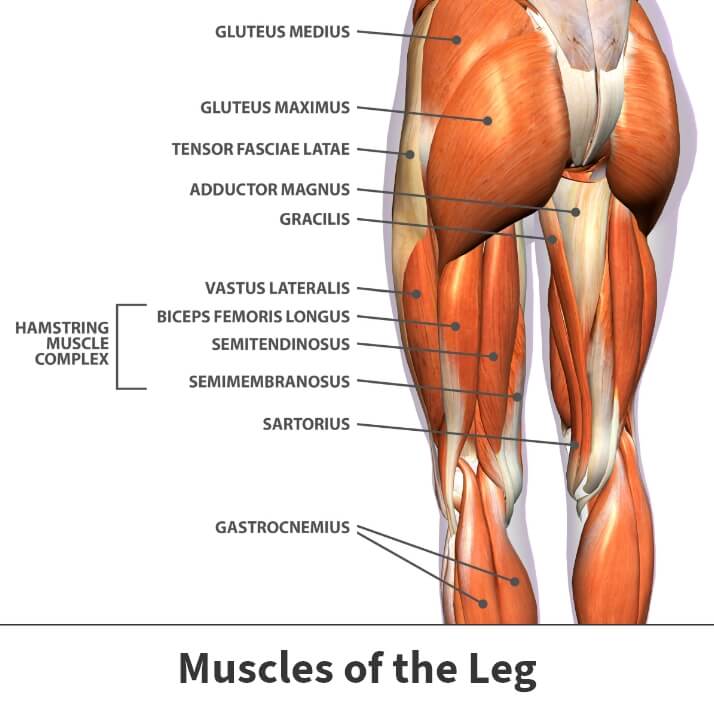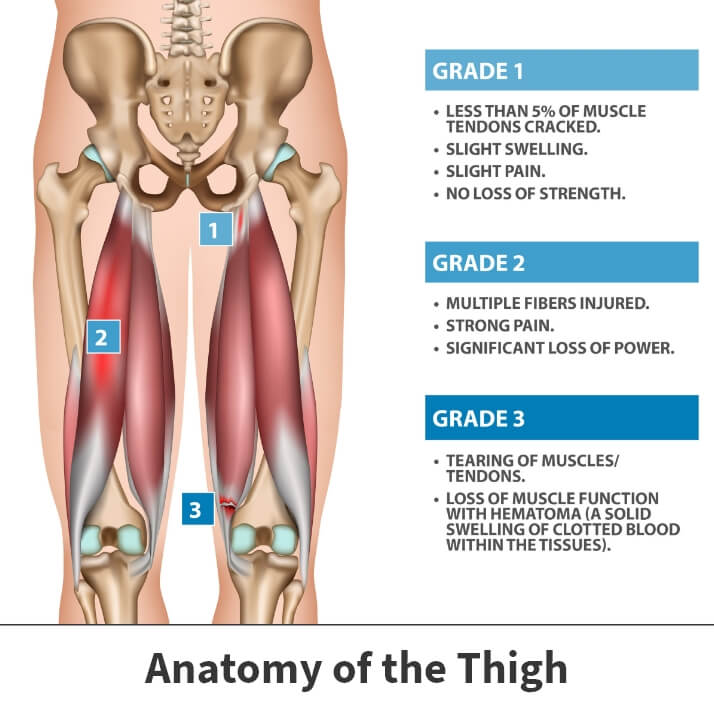Hamstring injuries
You rely on your upper legs and thighs to perform just about every movement – even simple actions like walking or standing. When these parts of your body become injured, significant discomfort and disability can occur. Hamstrings are part of your thigh region that are especially susceptible to injury.
Anatomy

The hamstrings are muscles that begin in the thigh and travel down your legs. Without the hamstrings, you would be unable to move your legs backward or flex your knee. The hamstring muscle complex is made up of three back thigh muscles between the hip and the knee: the semimembranosus, semitendinosus, and biceps femoris muscles.
About
Hamstring injuries occur when these muscles are strained. Strains are subdivided into simple pulls, partial muscle tears, or completely torn hamstrings. Strains are also placed into categories of severity, including:
- Grade 1 strains – Injury happens when the hamstring is slightly overextended but sustains no structural damage. In most cases, these strains heal relatively quickly and without significant medical intervention.
- Grade 2 strains – Strains happen when there are partial tears inside the hamstring muscles. These need more significant treatment and healing time.
- Grade 3 strains – The most serious of strains happen when your hamstrings are entirely torn. You may also damage tendons and adjacent bones. Torn hamstrings need aggressive treatment and take extended periods to heal.
Causes
Hamstring damage is caused by muscle overload. Muscle overload is defined as placing extensive pressure on an area or exposing it to a quick and excessively forceful trauma.
As you move your legs and thighs, your hamstring muscles contract and shorten. Injuries occur during either the contraction or shortening processes.
Risk factors
Hamstring injuries can occur whenever you extend your leg excessively or too quickly. Your risk might be increased if you experience or engage in:
- Muscle tightness – You are strongly encouraged to stretch muscles before participating in exercises. Improperly prepped muscles are usually tight. Tightness is a major strain-producing factor.
- Fatigue – Overworked hamstrings cannot absorb the energy necessary to perform at their best. This makes your hamstrings more vulnerable to injury.
- Muscle imbalances – Muscle imbalances happen when one group of muscles is stronger than another. Orthopedic doctors suggest this is a common cause of hamstring strains. The muscles in the front of your thighs, known as quadriceps muscles, are often stronger than your hamstrings. So naturally, the weaker muscle is more likely to become injured.
- Specific athletic activities – Certain sports or activities place greater stress on your hamstrings.
Your risk may increase if you partake in:
- Running
- Football
- Soccer
- Basketball
- Dancing
- Walking
One important issue is that younger athletes are more vulnerable because they are still growing, and their muscles are developing.

Symptoms
The most obvious sign of a hamstring injury is sharp, sudden pain in the back of your thigh. The pain may be powerful enough to force you to stop what you are doing immediately. Also, it may interfere with your ability to put weight on the leg or force you to fall.
Aside from moderate to intense pain, you might experience swelling, bruising, or discoloration in the area. More significant strains might also result in weakness which can make movement challenging.
Complications
If not properly diagnosed and treated, strains can worsen and impact other muscles, tendons, and bones.
Diagnosis
Doctors usually complete several steps before confirming a diagnosis.
The first examination phase involves a visual inspection of your injured thigh and leg to find swelling, discoloration, or any other obvious abnormality. Your doctor then might press or push the back of your leg to measure your pain threshold.
Your doctor might order imaging tests to capture internal scans of your hamstrings. X-rays, MRIs (magnetic resonance imaging), and CT (computerized tomography) scans allow doctors to examine images of the pulled or torn hamstring.
Treatment
The specific treatment your doctor chooses depends on several factors, including your:
- Age
- Fitness Level
- Injury severity
- Overall health
Mild to moderate strains may heal using natural treatment methods. Significantly torn hamstrings often require surgery.
Nonsurgical treatments
Simple, uncomplicated incidents respond well to a first-aid procedure nicknamed the RICE Method, which is short for:
- Resting the injured muscle
- Ice being applied
- Compressing the injured leg
- Elevating your injured leg above your heart
These four steps help increase blood flow and speed up the healing process.
You might also benefit from immobilization. This form of treatment involves placing your injured leg inside an immobilization device like a cast or splint. This prevents the muscle from moving, reduces the recovery period, and safeguards against further injury.
You may be prescribed physical therapy. Sometimes abbreviated simply as PT, is a set of individualized exercises created just for you, designed to help your leg regain or maintain its strength and recapture any lost motion ranges.
Learn More About Physical Therapy
Recovery
Minor to moderate hamstring strains often heal completely within a few weeks. If surgery is required, recovery will be significantly longer. Post-surgical recovery takes anywhere from three to six months before you can return to previous normal activities.
Prevention
Not all hamstring injuries are preventable. Incidents may occur after a fall or accident.
You can reduce your risk by stretching before any athletic activity and emphasizing muscle toning and strengthening.

Videos
Related specialties
- Anterior Hip Replacement
- Avascular Necrosis (Osteonecrosis)
- Groin Strains & Pulls
- Hip Arthroplasty
- Hip Arthroscopy
- Hip Dislocation
- Hip Flexor Strains
- Hip Fractures
- Hip Hemiarthroplasty
- Hip Impingement Labral Tears
- Hip Muscle Strains
- Hip Pointers & Trochanteric Bursitis
- Iliopsoas Tenotomy
- Labral Tears of the Hip (Acetabular Labrum Tears)
- Osteoarthritis of the Hip
- Osteoporosis
- Pelvic Ring Fractures
- Piriformis Syndrome
- Sports Hernias (Athletic Pubalgia)
- Thigh Fractures
- Thigh Muscle Strains
